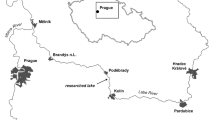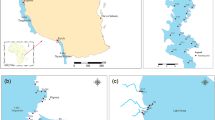Abstract
In the context of the environmental crisis observed in recent years in some areas in Baikal coastal zone, water chemistry was studied in June 2018 in seven points in this zone at different distances from populated localities and in six small tributaries of the lake. To compare data on different biological seasons lake water sampling was repeated in August–September 2019 in four previous and five additional points. Water mineralization was found to be minimal in the southern Baikal. The total mineralization of Baikal water remained relatively low, not exceeding the background values in previous decades; the concentration of environmentally hazardous elements is also low, except for the higher concentration of strontium in the thermal water of the Goryachinskii Creek. On the other hand, Baikal water in most points showed higher nitrogen content, and anomalously high phosphate concentration (0.413–0.941 mg/L) was recorded in the middle part of the lake (Barguzin Bay at Maksimikha Settl., at Svyatoi Nos Peninsula, and at Bol’shoi Ushkanii Isl.). Considerable enrichment of Baikal water by nutrients, which can provoke extremely high values of alga biomass in late summer and early autumn, was recorded not only near populated localities but also far from them and was not caused by inflow of these elements from tributaries. The sources of these pollutants are to be identified. In the late August–early September 2019, in the period of active consumption of phosphorus by summer phytoplankton and bottom algae, the concentration of phosphates in Middle Baikal decreased, remaining elevated (0.09 mg/L) near Maksimikha, but it abruptly rose (1.33 mg/L) in the thermal Goryachinskii Creek. In that period, water near Slyudyanka City (the southern part of the lake) was rich in nitrates (1.67–1.94 mg/L); their concentration was highest near Maksimikha (2.39 mg/L). The high concentration of nutrients in Baikal water requires extensive comprehensive measures to be taken to reduce the anthropogenic load onto lake ecosystem.

Similar content being viewed by others
REFERENCES
Votintsev, K.K., Gidrokhimiya ozera Baikal (Hydrochemistry of Lake Baikal), Moscow: Akad. Nauk SSSR, 1961.
Votintsev, K.K., Glazunov, I.V., and Tolmacheva, A.P., Gidrokhimiya rek basseina ozera Baikal (Hydrochemistry of Rivers in Lake Baikal Basin), Moscow: Nauka, 1965.
Geokhimicheskaya deyatel’nost’ mikroorganizmov gidroterm Baikal’skoi riftovoi zony (Geochemical Activity of Microorganisms in Thermal Springs in Baikal Rift Zone), Novosibirsk: Geo, 2011.
Domracheva, L.I., Dynamics of alga development in sod-podzol soil at daily determination, in Zakonomernosti razvitiya pochvennykh mikroorganizmov (Regularities in the Development of Soil Microorganisms), Leningrad: Zool. Inst. Akad. Nauk SSSR, 1975, pp. 38–52.
Domysheva, V.M. and Khodzher, T.V., Baikal Hydrochemistry. Lake Chemical Balance, in Baikalovedenie (Studies of Baikal), Novosibirsk: Nauka, 2012, book 1, pp. 206–224.
Kolichestvennyi khimicheskii analiz vod. Metodika vypolneniya izmerenii massovoi kontsentratsii elementov v probakh pit’evoi, prirodnykh, stochnykh vod i atmosfernykh osadkov metodom atomno-emissionnoi spektrometrii s induktivno-svyazannoi plazmoi (Quantitative Chemical Analysis of Water. Methods of Measuring the Mass Concentrations of Elements in Samples of Drinking, Natural, and Waste Waters and Precipitation by Atomic Emission Spectrometry with Inductively Coupled Plasma). PND F 14.1:2:4.135-98, Moscow, 2008.
Kolichestvennyi khimicheskii analiz vod. Metodika izmerenii massovoi kontsentratsii fosfat-ionov v pit’evykh, poverkhnostnykh i stochnykh vodakh fotometricheskim metodom s molibdatom ammoniya. Utverzhdena Ministerstvom okhrany okruzhayushchei sredy i prirodnykh resursov RF 21.03.1997 (Quantitative Chemical Analysis of Water. Methods for Measuring the Mass Concentration of Phosphate Ions in Drinking, Surface, and Waste Water by Photometric Method with Ammonium Molybdate. Approved by the RF Ministry of Environmental Protection and Natural Resources, March 21, 1997), Moscow: Federal Center for the Analysis and Assessment of Technogenic Impact), 2011.
Kravtsova, L.S., Izhboldina, L.A., Khanaev, I.V., Pomazkina, G.V., Domysheva, V.M., Kravchenko, O.S., and Grachev, M.A., Disturbance of the vertical zonality of green algae in the open Listvennichnyi Bay of Lake Baikal as a consequence of local anthropogenic impact, Dokl. Ross. Akad. Nauk, 2012, vol. 447, no. 2, pp. 227–229.
Kulikova, N.N., Chebykin, E.P., Volkova, E.A., Bondarenko, N.A., Vodneva, E.N., and Suturin, A.N., Determining elemental composition of benthic macroalgae for water quality indication in the shallow zone of Listvennichnyi Bay (Southern Baikal), Mezhdunar. Nauch.-Issl. Zhurn., 2017, no. 12.
Kulikova, N.N., Volkova, E.A., Bondarenko, N.A., Chebykin, E.P., Saibatalova, E.V., Timoshkin, O.A., and Suturin, A.N., Element composition and biogeochemical functions of algae Ulothrix zonata (F. Weber et Mohr) Kützing in the coastal zone of the Southern Baikal. Water Resour., 2018, vol. 45, no. 6, pp. 908–919.
Kurlov, M.G., Klassifikatsiya sibirskikh tselebnykh mineral’nykh vod (Classification of Siberian Medicinal Mineral Waters), Tomsk: Fizioterapevtich. Inst., 1928.
Lomonosov, I.S., Kustov, Yu.I., and Pinneker, E.V., Mineral’nye vody Pribaikal’ya (Mineral Waters of Baikal Region), Irkutsk: Vost.-Sib. Kn. Izd., 1977.
Plyusnin, A.M., Hydrogeochemical regime of groundwater, Baikal: priroda i lyudi. Entsiklopedicheskii spravochnik (Baikal: Nature and People. Encyclopedic Reference Book), Ulan-Ude: EKOS; Izd. Bur. Nauch. Ts. Sib. Otd. Ross. Akad. Nauk, 2009, pp. 263–271.
Plyusnin, A.M., Zamana, L.V., Shvartsev, S.L., Tokarenko, O.G., and Chernyavskii, M.K., Hydrogeochemical features of the composition of nitrogen therms of Baikal Rift Zone, Geol. Geofiz., 2013, vol. 54, no. 5, pp. 647–664.
Potemkina, T.G., Potemkin, V.L., and Fedotov, A.P., Climatic factors and risks of modern environmental changes in the coastal zone of Baikal Lake, Geol. Geofiz., 2018, vol. 59, no. 5, pp. 690–702.
Reznikov, A.A., Mulikovskaya, E.P., and Sokolov, I.Yu., Metody analiza prirodnykh vod (Methods for the Analysis of Natural Waters), Moscow: Nedra, 1970.
Sorokovikova, L.M., Sinyukovich, V.N., Tomberg, I.V., Popovskaya, G.I., Chernyshov, M.S., Ivanov, V.G., and Khodzher, T.V., The status of the aquatic ecosystem of the Selenga river delta under long-duration low-water conditions, Geogr. Nat. Resour., 2017, no. 1, pp. 60–67.
Suturin, A.N., Chebykin, E.P., Mal’nik, V.V., Khanaev, I.V., Minaev, A.V., and Minaev, V.V., The role of anthropogenic factors in ecological stress development in the littoral zone of Lake Baikal (water area near Listvyanka Settl.), Geogr. Prir. Res., 2016, no. 6, pp. 43–54.
Takhteev, V.V., Lopatovskaya, O.G., Okuneva, G.L., Pomazkova, G.I., Samoilova, E.A., and Rozhkova, N.A., Ecological description of the sodium chloride mineral springs in the Kirenga River basin and the upper reaches of the Lena River: 1. General characteristics of the springs and their hydrofauna, Inland Water Biol., 2017, no. 4, pp. 331–341.
Timoshkin, O.A., Bondarenko, N.A., Volkova, E.A., Tomberg, I.V., Vishnyakov, V.S., and Mal’nik, V.V., Mass development of green filamentous algae of genera Spirogyra and Stigeoclonium in the coastal zone of the Southern Baikal, Gidrobiol. Zh., 2014, vol. 50, no. 5, pp. 15–26.
Tomberg, I.V., Sorokovikova, L.M., Popovskaya, G.I., Bashenkhaeva, N.V., Sinyukovich, V.N., and Ivanov, V.G., Concentration dynamics of biogenic elements and phytoplankton at Selenga R. mouth and in Selenga shallows (Lake Baikal), Water Resour., 2014, vol. 41, no. 6, pp. 687–695.
Khanaev, I.V., Dzyuba, E.V., Kravtsova, L.S., and Grachev, M.A., The effect of mass development of green filamentous algae on the reproduction of Baikal sculpin Cottocomephorus grewingkii (Dybowski, 1874) (Cottidae) under the ecological crisis of Lake Baikal, Dokl. Ross. Akad. Nauk, 2016, vol. 467, no. 1, pp. 119–121.
Ekologicheskii atlas basseina ozera Baikal (Ecological Atlas of Baikal Lake Basin), Irkutsk: Izd. Inst. Geogr. im. V.B. Sochavy Sib. Otd. Ros. Akad. Nauk, 2015.
Katano, T., Nakano, Sh., Ueno, H., Mitamura, O., Anbutsu, K., Masayuki, K., Satoh, Ya., Satoh, T., Drucker, V.V., Tanaka, Yu., Akagashi, Yu., and Sugiyama, M., Abundance and composition of the summer phytoplankton community along a transect from the Barguzin River to the central basin of Lake Baikal, Limnology, 2008, vol. 9, pp. 243–250.
Kobanova, G.I., Takhteev, V.V., Rusanovskaya, O.O., and Timofeyev, M.A., Lake Baikal ecosystem faces the threat of eutrophication, Int. J. Ecol., Article ID 6 058 082. 7 p. https://doi.org/10.1155/2016/6058082
Timoshkin, O.A., Samsonov, D.P., Yamamuro, M., et al., Rapid ecological change in the coastal zone of Lake Baikal (East Siberia): Is the site of the world’s greatest freshwater biodiversity in danger?, J. Great Lakes Res., 2016, vol. 42, no. 3, pp. 487–497.
Timoshkin, O.A., Coastal zone of the world’s great lakes as a target field for interdisciplinary research and ecosystem monitoring: Lake Baikal (East Siberia), Limnol. Freshwater Biol., 2018, vol. 1, pp. 81–97.
www. lin.irk.ru/files/tim.pdf.
Funding
This study was supported by the Russian Foundation for Basic Research, project nos. 17-29-05067-ofi-m, 19-34-90062-Postgraduates.
Author information
Authors and Affiliations
Corresponding author
Rights and permissions
About this article
Cite this article
Takhteev, V.V., Khadeeva, E.R., Eropova, I.O. et al. Water Chemistry in Small Tributaries and the Coastal Zone of Lake Baikal in the Period of Environmental Crisis. Water Resour 47, 448–458 (2020). https://doi.org/10.1134/S0097807820030161
Received:
Revised:
Accepted:
Published:
Issue Date:
DOI: https://doi.org/10.1134/S0097807820030161




